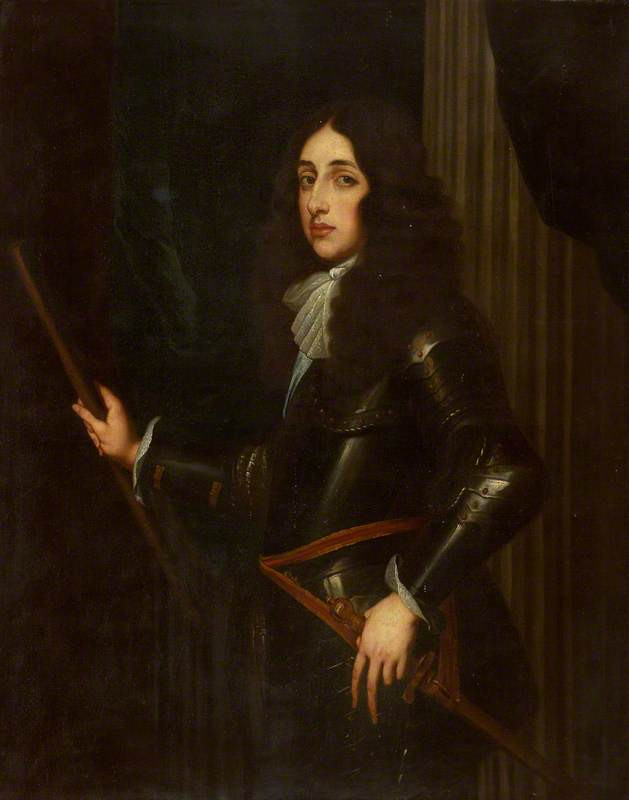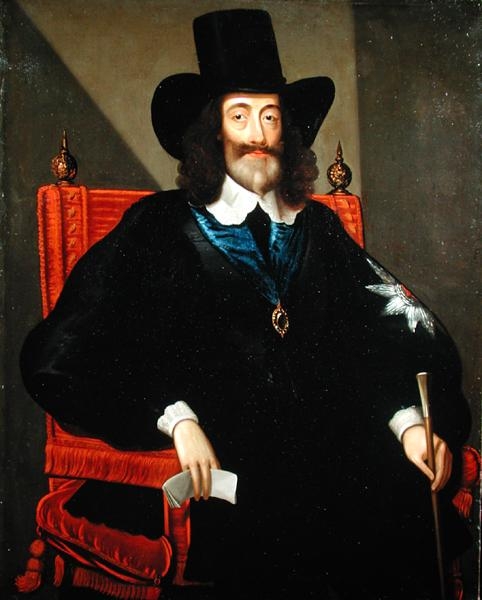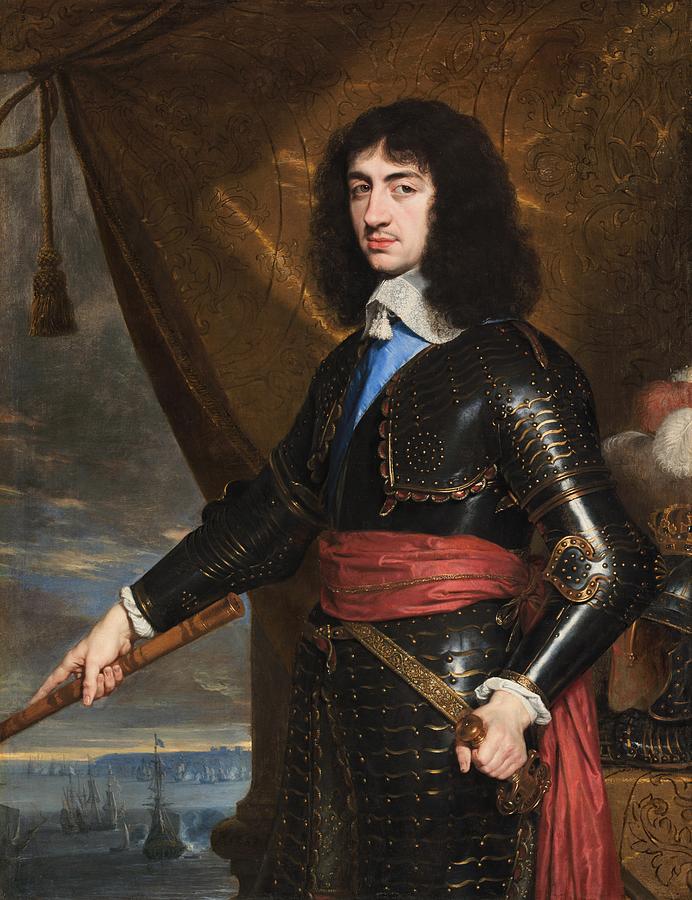by Susan Flantzer
© Unofficial Royalty 2023

Prince Henry, Duke of Gloucester; Credit – Wikipedia
Henry Stuart, Prince of England, Duke of Gloucester was born on July 8, 1640, at Oatlands Palace, a Tudor and Stuart royal palace near Weybridge in Surrey, England. He was the youngest of the four sons and the eighth of the nine children of King Charles I of England and Henrietta Maria of France. Henry’s paternal grandparents were King James I of England and Anne of Denmark. His maternal grandparents were King Henri IV of France and his second wife Marie de’ Medici.

King Charles I’s five eldest surviving children in 1637: Left to right: Mary, James, Charles, Elizabeth, and Anne; Credit – Wikipedia
Henry had eight siblings:
- Prince Charles James of England, Duke of Cornwall and Rothesay, born and died May 13, 1629
- King Charles II of England (1630 – 1685), married Catherine of Braganza, no children, but Charles II had at least 14 illegitimate children
- Mary, Princess Royal (1631 – 1660), married Willem II, Prince of Orange, had one child: Willem III, Prince of Orange, later King William III of England
- King James II of England (1633 – 1701), married (1) Anne Hyde, had eight children, but only two survived childhood, both reigning Queens: Queen Mary II of England and Queen Anne of England (2) Maria Beatrice of Modena, had seven children but only two survived childhood including James Francis Edward Stuart, The Old Pretender
- Princess Elizabeth of England (1635 – 1650), died in her teens from pneumonia
- Princess Anne of England (1637 – 1640) died young from tuberculosis
- Princess Catherine of England, born and died June 29, 1639
- Princess Henrietta of England (1644 – 1670), married her first cousin Philippe, Duke of Orléans, had three children
Henry was well connected to European royalty through his maternal aunts and uncles: King Louis XIII of France; Elisabeth of France, Queen of Spain, wife of King Felipe IV of Spain; Christine Marie of France, Duchess of Savoy, wife of Vittorio Amedeo I, Duke of Savoy; and Gaston of France, Duke of Orléans. His only surviving paternal aunt or uncle was Elizabeth Stuart who had married Friedrich V, Elector Palatine. Through Elizabeth and Friedrich’s daughter Sophia, the Protestant Hanovers came to the British throne in 1714 via the 1701 Act of Settlement.
Henry’s father King Charles I had issues with Parliament, clashing with its members over financial, political, and religious issues. These issues eventually caused the English Civil War (1642 – 1651). During the English Civil War, of Henry’s surviving siblings, his sister Mary was married and living in the Dutch Republic, his eldest brother Charles, the future King Charles II, had fled England and was in the Dutch Republic with their sister Mary or in France where their mother Queen Henrietta Maria and sister Henrietta were living in exile, and where their young first cousin King Louis XIV sat upon the throne of France. Henry’s brother James, the second son, remained in Oxford, England, the royalist stronghold, while his father King Charles I fought against the forces of the Parliamentarians, also known as the Roundheads.

(Left to Right) Prince Henry, Duke of Gloucester, Princess Elizabeth and Prince James, Duke of York, the future King James II; Credit – Wikipedia
Henry and his elder sister Elizabeth could not flee with their mother because they were not with her then. They remained in England and were placed under the care of the Parliamentarians. For several years, Elizabeth and Henry were moved from one residence to another due to the plague. Their governesses and guardians periodically changed. When the city of Oxford surrendered in 1646, Elizabeth and Henry’s elder brother James was arrested and placed with them in St. James’ Palace in London. In 1647, their father Charles I was arrested, and during the years 1647 – 1648, he was allowed to see his three children who were in England several times. In 1648, James managed to escape and fled to the Dutch Republic, where his sister Mary lived. James had wanted to take Henry with him but Elizabeth was afraid to let her younger brother go.

Henry’s father King Charles I at his trial; Credit – Wikipedia
On January 20, 1649, the trial of King Charles I began at Westminster Hall in London, England. He was accused of treason against England by using his power to pursue his personal interest rather than the good of England. He was declared guilty and sentenced to death on January 27, 1649. On January 29, 1649, the day before his execution, Charles was allowed to see 13-year-old Elizabeth and 8-year-old Henry at St. James’s Palace in London where he was being held. He told Elizabeth to be faithful to the “true Protestant religion” and to tell her mother that “his thoughts had never strayed from her.” He warned Henry to “not be made a king” by the Parliamentarians because he suspected they would make the boy a puppet king. Charles divided his jewels between the two children, keeping only his George, an enameled figure of St. George, worn as a part of the ceremonial dress of the Order of the Garter. He gave Elizabeth his Bible.

A 19th-century depiction of Elizabeth and Henry at Carisbooke Castle; Credit – Wikipedia
After the execution of their father, Henry and Elizabeth became unwanted charges. Parliament refused to allow them to go to the Dutch Republic. Robert Sidney, 2nd Earl of Leicester and his wife Dorothy agreed to take charge of Henry and Elizabeth at their home, Penshurst Place in Penhurst, Kent, England, 32 miles/51 km from London. However, in 1650, when Henry and Elizabeth’s eldest brother, now the titular King Charles II, traveled to Scotland to be crowned King of Scots, Parliament decided they needed to be in a more secure place, far away from London. Henry and Elizabeth were moved to Carisbrooke Castle on the Isle of Wight, England. The number of their servants was reduced to four people. Henry and Elizabeth were deprived of their prince and princess titles and Henry was additionally deprived of his Duke of Gloucester title.
On August 23, 1650, less than a week after arriving at Carisbrooke Castle, Elizabeth began to feel ill. On September 1, she went to bed and could no longer get up. She died on September 8, 1650, aged fourteen, probably from pneumonia. She was buried in a small crypt under the altar at Saints Thomas Church in Newport, on the Isle of Wight. Ten-year-old Henry was now all alone. He remained at Carisbrooke Castle until 1652 when he was allowed to leave England and travel to his sister Mary in the Dutch Republic. On Easter Sunday in 1653, Henry was created a Knight in the Order of the Garter by his brother Charles.

Prince Henry, portrait by Adriaen Hanneman, circa 1653; Credit – Wikipedia
Eventually, Henry joined his mother Henrietta Maria in her native Paris, France. They had not seen each other for more than ten years. Henry’s elder brother Charles wanted to take Henry with him when he left Paris but Henrietta Maria wanted to keep her youngest son with her. Charles agreed but on the condition that his mother would not try to get Henry to change his religion from Protestantism to his mother’s Roman Catholicism. Henrietta Maria promised Charles she would not try to convert Henry to Catholicism but did not keep her word. When Charles found out, he ordered Henry to join him in Cologne, a free imperial city, within the Holy Roman Empire, now in Germany. Henrietta Maria’s attempts to convert Henry to Catholicism not only failed and angered the royalists and Charles but also completely ruined her relationship with her youngest son.

Henry’s mother Henrietta Maria; Credit – Wikipedia
Henry remained with his brother Charles in Cologne until 1656 when the brothers left for Bruges, now in Belgium, then the capital of the County of Flanders. Later in 1656, Henry and his elder brother James (the future King James II) joined the English regiment of the Spanish Habsburg army fighting against the French in the 1635 – 1659 Franco-Spanish War.

Henry’s eldest brother Charles in exile; Credit – Wikipedia
On September 3, 1658, Oliver Cromwell, the Lord Protector of the Commonwealth of England, Scotland, and Ireland, died. His son Richard Cromwell ruled only until April 1659 and there was a real possibility for the restoration of the monarchy. On May 13, 1659, Charles II restored Henry’s title of Duke of Gloucester and additionally created him Earl of Cambridge. Parliament formally invited Charles, as King Charles II, to be the English monarch on May 1, 1660, in what has become known as The Restoration. On May 23, 1660, Charles landed at Dover, England on his 30th birthday, and Henry accompanied him.
The Palace of Whitehall in London where Henry settled upon his return to England and where he died
Henry settled in the Palace of Whitehall in London. On June 13, 1660, Henry was appointed Chief Steward of Gloucester, on June 30, 1660, he began to sit in the House of Lords, and on July 3, 1660, he was appointed Ranger of Hyde Park. King Charles II planned to betroth Henry to Princess Wilhelmine Ernestine of Denmark to reinforce the English-Danish alliance, and King Frederik III of Denmark had agreed to the marriage.
In 1660, there was a smallpox epidemic in London and twenty-year-old Henry became ill with the disease. He died on September 13, 1660, at the Palace of Whitehall in London, England. Henry’s remains were moved to Somerset House in London on September 21, 1660, and then taken down the River Thames to Westminster Abbey where he was buried in the south aisle of the Henry VII Chapel in the vault where his great-grandmother Mary, Queen of Scots is buried. Several English Stuart descendants of Mary, Queen of Scots are also buried in her vault. Their names are engraved on a stone memorial between the tombs of Mary, Queen of Scots and Margaret Douglas, Countess of Lennox.
Henry’s death overshadowed the joy of a family reunion. In May 1660, Mary, Princess Royal, Dowager Princess of Orange had watched as her brothers Charles and James sailed away from the Dutch Republic, returning to England upon the restoration of the English throne to the Stuarts. Mary returned to her birth country in September 1660. Although the court was in mourning for her brother Henry, Duke of Gloucester, her brothers Charles and James traveled down the River Thames to meet her. This was the second smallpox death Mary had to endure. In 1650, Mary was pregnant with her first child when her husband Willem II, Prince of Orange fell ill with smallpox, and died on November 6, 1650, at the age of 24. Eight days later, on November 14, 1650, Mary gave birth to her only child Willem III, Prince of Orange at birth, later also King William III of England.
Sadly, Mary did not have much time to celebrate the restoration of her brother King Charles II. On December 20, 1660, it was obvious that Mary had contracted smallpox, and by the next day, she was dangerously ill. She died on December 24, 1660, at the Palace of Whitehall in London, England at the age of 29. On her deathbed, Mary expressed her wish to be buried next to her brother Henry, and so she was. Her son Willem III, Prince of Orange was just ten years old and had lost both parents to smallpox. Thirty-four years later, when Mary’s son Willem and his wife and first cousin Mary (daughter of his uncle King James II), co-reigned in England as King William III and Queen Mary II, his wife Mary would also die of smallpox at the age of 32.
This article is the intellectual property of Unofficial Royalty and is NOT TO BE COPIED, EDITED, OR POSTED IN ANY FORM ON ANOTHER WEBSITE under any circumstances. It is permissible to use a link that directs to Unofficial Royalty.
Works Cited
- Flantzer, Susan. (2023) Elizabeth Stuart, Princess of England, Daughter of King Charles I of England, Unofficial Royalty. Available at: https://www.unofficialroyalty.com/princess-elizabeth-of-england-daughter-of-king-charles-i-of-england/ (Accessed: February 16, 2023).
- Flantzer, Susan. (2020) Execution of Charles I, King of England (1649), Unofficial Royalty. Available at: https://www.unofficialroyalty.com/execution-of-charles-i-king-of-england-1649/ (Accessed: February 16, 2023).
- Flantzer, Susan. (2016) Henrietta Maria of France, Queen of England, Unofficial Royalty. Available at: https://www.unofficialroyalty.com/henrietta-maria-of-france-queen-of-england/ (Accessed: February 16, 2023).
- Flantzer, Susan. (2016) King Charles I of England, Unofficial Royalty. Available at: https://www.unofficialroyalty.com/king-charles-i-of-england (Accessed: February 16, 2023).
- Henry, Duke of Gloucester (2023) Westminster Abbey. Available at: https://www.westminster-abbey.org/abbey-commemorations/royals/henry-duke-of-gloucester (Accessed: February 16, 2023).
- Henry Stuart, Duke of Gloucester (2023) Wikipedia. Wikimedia Foundation. Available at: https://en.wikipedia.org/wiki/Henry_Stuart,_Duke_of_Gloucester (Accessed: February 16, 2023).
- Weir, Alison. (1989) Britain’s Royal Families: The Complete Genealogy. London: Vintage Books.
- Williamson, David. (1996) Brewer’s British Royalty: A Phrase and Fable Dictionary. London: Cassell.
